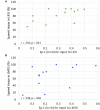The Relationship between Frontotemporal Effective Connectivity during Picture Naming, Behavior, and Preserved Cortical Tissue in Chronic Aphasia
- PMID: 27014039
- PMCID: PMC4792868
- DOI: 10.3389/fnhum.2016.00109
The Relationship between Frontotemporal Effective Connectivity during Picture Naming, Behavior, and Preserved Cortical Tissue in Chronic Aphasia
Abstract
While several studies of task-based effective connectivity of normal language processing exist, little is known about the functional reorganization of language networks in patients with stroke-induced chronic aphasia. During oral picture naming, activation in neurologically intact individuals is found in "classic" language regions involved with retrieval of lexical concepts [e.g., left middle temporal gyrus (LMTG)], word form encoding [e.g., left posterior superior temporal gyrus, (LpSTG)], and controlled retrieval of semantic and phonological information [e.g., left inferior frontal gyrus (LIFG)] as well as domain-general regions within the multiple demands network [e.g., left middle frontal gyrus (LMFG)]. After stroke, lesions to specific parts of the left hemisphere language network force reorganization of this system. While individuals with aphasia have been found to recruit similar regions for language tasks as healthy controls, the relationship between the dynamic functioning of the language network and individual differences in underlying neural structure and behavioral performance is still unknown. Therefore, in the present study, we used dynamic causal modeling (DCM) to investigate differences between individuals with aphasia and healthy controls in terms of task-induced regional interactions between three regions (i.e., LIFG, LMFG, and LMTG) vital for picture naming. The DCM model space was organized according to exogenous input to these regions and partitioned into separate families. At the model level, random effects family wise Bayesian Model Selection revealed that models with driving input to LIFG best fit the control data whereas models with driving input to LMFG best fit the patient data. At the parameter level, a significant between-group difference in the connection strength from LMTG to LIFG was seen. Within the patient group, several significant relationships between network connectivity parameters, spared cortical tissue, and behavior were observed. Overall, this study provides some preliminary findings regarding how neural networks for language reorganize for individuals with aphasia and how brain connectivity relates to underlying structural integrity and task performance.
Keywords: aphasia; behavioral performance; cortical damage; dynamic causal modeling; effective connectivity; fMRI; oral picture naming.
Figures










Similar articles
-
Investigating Language and Domain-General Processing in Neurotypicals and Individuals With Aphasia - A Functional Near-Infrared Spectroscopy Pilot Study.Front Hum Neurosci. 2021 Sep 17;15:728151. doi: 10.3389/fnhum.2021.728151. eCollection 2021. Front Hum Neurosci. 2021. PMID: 34602997 Free PMC article.
-
Left frontotemporal effective connectivity during semantic feature judgments in patients with chronic aphasia and age-matched healthy controls.Cortex. 2018 Nov;108:173-192. doi: 10.1016/j.cortex.2018.08.006. Epub 2018 Aug 27. Cortex. 2018. PMID: 30243049 Free PMC article.
-
The involvement of left inferior frontal and middle temporal cortices in word production unveiled by greater facilitation effects following brain damage.Neuropsychologia. 2018 Dec;121:122-134. doi: 10.1016/j.neuropsychologia.2018.10.026. Epub 2018 Nov 1. Neuropsychologia. 2018. PMID: 30391568
-
Neural Resources Supporting Language Production vs. Comprehension in Chronic Post-stroke Aphasia: A Meta-Analysis Using Activation Likelihood Estimates.Front Hum Neurosci. 2021 Oct 25;15:680933. doi: 10.3389/fnhum.2021.680933. eCollection 2021. Front Hum Neurosci. 2021. PMID: 34759804 Free PMC article.
-
Remapping and Reconnecting the Language Network after Stroke.Brain Sci. 2024 Apr 24;14(5):419. doi: 10.3390/brainsci14050419. Brain Sci. 2024. PMID: 38790398 Free PMC article. Review.
Cited by
-
Investigating Language and Domain-General Processing in Neurotypicals and Individuals With Aphasia - A Functional Near-Infrared Spectroscopy Pilot Study.Front Hum Neurosci. 2021 Sep 17;15:728151. doi: 10.3389/fnhum.2021.728151. eCollection 2021. Front Hum Neurosci. 2021. PMID: 34602997 Free PMC article.
-
Orthographic Visualisation Induced Brain Activations in a Chronic Poststroke Global Aphasia with Dissociation between Oral and Written Expression.Case Rep Neurol Med. 2019 Jul 2;2019:8425914. doi: 10.1155/2019/8425914. eCollection 2019. Case Rep Neurol Med. 2019. PMID: 31355031 Free PMC article.
-
Neuroplasticity in Aphasia: A Proposed Framework of Language Recovery.J Speech Lang Hear Res. 2019 Nov 22;62(11):3973-3985. doi: 10.1044/2019_JSLHR-L-RSNP-19-0054. Epub 2019 Nov 22. J Speech Lang Hear Res. 2019. PMID: 31756154 Free PMC article. Review.
-
Demographic Effects on Longitudinal Semantic Processing, Working Memory, and Cognitive Speed.J Gerontol B Psychol Sci Soc Sci. 2020 Oct 16;75(9):1850-1862. doi: 10.1093/geronb/gbaa080. J Gerontol B Psychol Sci Soc Sci. 2020. PMID: 32609841 Free PMC article.
-
The Domain-General Multiple Demand (MD) Network Does Not Support Core Aspects of Language Comprehension: A Large-Scale fMRI Investigation.J Neurosci. 2020 Jun 3;40(23):4536-4550. doi: 10.1523/JNEUROSCI.2036-19.2020. Epub 2020 Apr 21. J Neurosci. 2020. PMID: 32317387 Free PMC article.
References
Grants and funding
LinkOut - more resources
Full Text Sources
Other Literature Sources
Medical

